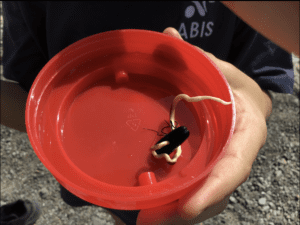Year-to-Date: 440; Mar 2023: 112.2; Last Week: 35.4
Quite often in IB PYP programs, teachers focus on the inquiry cycle; however, there are other worthwhile learning cycles to consider. One that comes to mind is the experiential cycle of learning. I bring up this idea because this learning process is more applicable to G5’s recent experience in the Wadi Hibi area. The experiential cycle of learning involves four steps, which stay in perpetual motion because people are always learning. The touchstone steps are an experience, a reflection on that experience, generalizations to form learning, and application or transferability to new experiences.
Concrete Experience On Monday morning, G5 in its entirety traveled to Wadi Ahin up Wadi Hibi road; it’s the part of the wadi that creates a horseshoe bounded by the road and the first place where there is consistently water. Teachers provided transparent containers, bags, and nets for students to catch and release living things from the wadi. Students brought iPads to document these living things with the intention that they would find facts later in the week. Please check out photographs from teachers and students at your convenience.
Reflective Observation A student approached me with an object in a red lid for a photograph. I snapped the photo and they quickly returned the object to a place in the water where the water was running; not much but enough so that the water was not still. We shared an ever-so-brief conversation about what we observed (or thought that we had observed). We noticed that the black oval was quite stationary but the slim black tendrils moved. The cream colored part moved but so slow that is was almost unnoticeable. We wondered what this was … What do you think it is?
Abstract Conceptualization At first, I agreed with the student that this object was some sort of seed. A day or so later when we continued learning on campus, we both wondered if this object might be an animal instead of a plant. We really didn’t know even when we consulted with other teachers and students for their ideas. Enter Google Lens; it’s this extraordinary feature in the Google search bar. We entered this photograph and zoomed in on different areas. It was thought to be a lobster or a crab when there was mostly red, a cockroach or firefly when there was mostly black, or a parasitic worm when all of the parts were within the frame. Interestingly, it was never a suggestion from Google Lens that this object was a seed. Seriously, what is this?
Active Experimentation As far as we observed (and that we know), this object is living and more than likely an animal rather that a plant. Since the entire goal of this unit is how we share the planet, all fish, toads, roaches, dragonflies, and whatever this is were caught, photographed, and released. This means that we have the photograph but not the specimen. Although we are unsure about how to classify this life form, we sure learnt a lot about the desert biome and this wadi’s ecosystem. Even though the desert seems like all of the rocks support little life, when we look hard enough we might be surprised with what we find.

